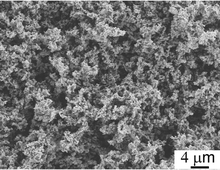Synthesis and characterization of SiC materials with hierarchical porosity obtained by replication techniques
Abstract
Porous silicon carbide monoliths were obtained using the infiltration of preformed SiO2 frameworks with appropriate carbon precursors such as mesophase pitch. The initial SiO2 monoliths possessed a hierarchical pore system, composed of an interpenetrating bicontinuous macropore structure and 13 nm mesopores confined in the macropore walls. After carbonization, further heat treatment at ca. 1400 °C resulted in the formation of a SiC–SiO2 composite, which was converted into a porous SiC monolith by post-treatment with ammonium fluoride solution. The resulting porous SiC featured high crystallinity, high chemical purity and showed a surface area of 280 m2 g−1 and a pore volume of 0.8 ml g−1.


 Please wait while we load your content...
Please wait while we load your content...